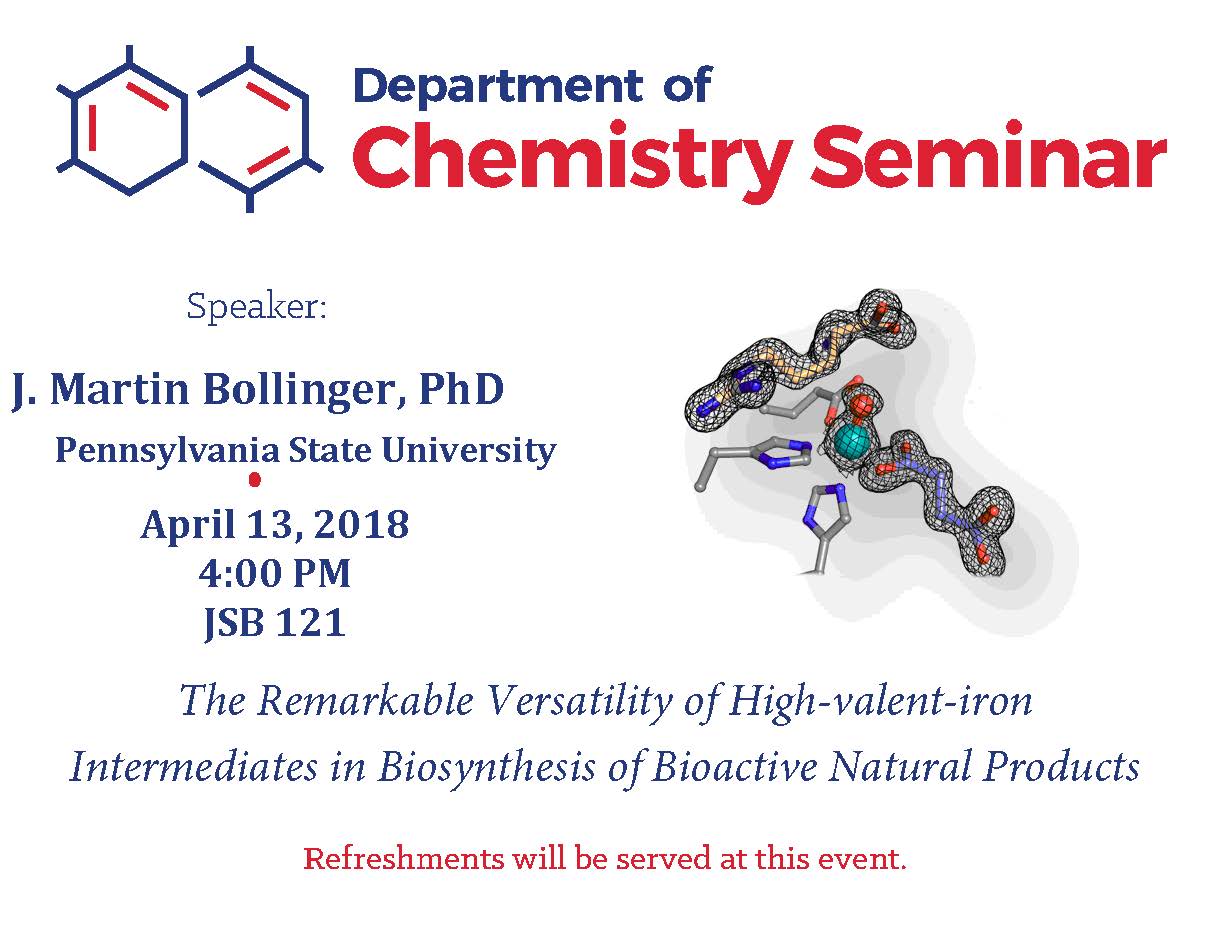Iron enzymes activate dioxygen for a large number of biomedically, agriculturally, and environmentally important oxidation reactions. Among those that use non-heme mono-iron cofactors, protein ligand sets as minimal as a pair of cis histidines enable the cofactor to coordinate and approximate as many as three different substrates, leading to an astounding array of different reaction types. Many of these reactions install key functional groups in lucrative natural-product drugs. Over the last 15 years, we have established the intermediacy of iron(IV)-oxo (ferryl) complexes in the reactions of several such enzymes with a range of distinct outcomes.1 In general, the ferryl intermediates generate substrate radicals by abstracting hydrogen (H•) from unactivated aliphatic carbons,2-6 initiating formation of new C–O,2-4 C–Cl/Br,5,6 C–S,7 C–N,8 or C–C bonds.9 Hydroxylation is the default outcome, as it results from coupling between the carbon radical and the necessarily adjacent Fe(III)-coordinated oxygen that just generated it (termed “oxygen rebound” by Groves). Thus, the first imperative for enzymes that mediate outcomes other than hydroxylation is to avoid the default rebound, which generally has a low activation barrier. In our current work, we are defining the manifold of other pathways by which the substrate radical can decay and the strategies by which a given protein scaffold (or, in rare cases, the substrate itself) specifies a reaction channel. A generally important parameter is the disposition of the substrate relative to the cofactor,10 which appears to be controlled not only by the substrate pocket but also by the geometry of the ferryl complex (oxo trans to either one of the two conserved histidine ligands).11 It has therefore been important to have tools to visualize intermediates (especially the ferryl complexes) through the reaction sequences.12,13 I will summarize several of the Penn State team’s recent successes in defining reaction pathways and explaining control of outcome in this versatile enzyme family.
1. Krebs, C., Galonic, D.; Walsh, C. T.; Bollinger, J. M., Jr. "Non-Heme Fe(IV)-Oxo Intermediates," Acc. Chem. Res., 2007, 40, 484-492.
2. Price, J. C.; Barr, E. W.; Tirupati, B.; Bollinger, J. M., Jr.; Krebs, C.; “The First Direct Characterization of a High-Valent Iron Intermediate in the Reaction of an aKetoglutarate-Dependent Dioxygenase: A High-Spin Fe(IV) Complex in Taurine:a-Ketoglutarate Dioxygenase (TauD) from Escherichia coli,” Biochemistry, 2003, 42, 7497-7508.
3. Price, J. C.; Barr, E. W.; Glass, T. E.; Krebs, C.; Bollinger, J. M., Jr.; “Evidence for Hydrogen Abstraction from C1 of Taurine by the High-Spin Fe(IV) Intermediate Detected during Oxygen Activation by Taurine:a-Ketoglutarate Dioxygenase (TauD),” J. Am. Chem. Soc., 2003, 125, 13008-13009.
4. Hoffart, L. M.; Barr, E. W.; Guyer, R. B.; Bollinger, J. M., Jr.; Krebs, C. “Direct spectroscopic detection of a C-H-cleaving high-spin Fe(IV) complex in a prolyl-4-hydroxylase,” Proc. Natl. Acad. Sci. USA, 2006, 103, 14738-14743.
5. Galonic, D. P.; Barr, E. W.; Walsh, C. T.; Bollinger, J. M., Jr.; Krebs, C. “Two Interconverting Fe(IV) Intermediates in Aliphatic Chlorination by the Halogenase CytC3,” Nat. Chem. Biol., 2007, 3, 113-116.
6. Matthews, M. L.; Krest, C. M.; Barr, E. W.; Vaillancourt, F. H.; Walsh, C. T.; Green, M. T.; Krebs, C.; Bollinger, J. M., Jr. “Substrate-Triggered Formation and Remarkable Stability of the C-H Bond-Cleaving Chloroferryl Intermediate in the Aliphatic Halogenase, SyrB2,” Biochemistry, 2009, 48, 4331-4343.
7. Tamanaha, E. Y.; Zhang, B.; Guo, Y.; Chang, W.-c.; Barr, E. W.; Xing, G.; St. Clair, J.; Ye, S.; Neese, F.; Bollinger, J. M., Jr.; Krebs, C. “Spectroscopic evidence for the two C-H-cleaving intermediates of Aspergillus nidulans isopenicillin N synthase," J. Am. Chem. Soc. 2016, 138, 8862-8874.
8. Matthews, M.L.; Chang, W.-c.; Layne, A.P.; Miles, L.A.; Krebs, C.; Bollinger, J. M., Jr. “Direct Nitration and Azidation of Aliphatic Carbons by an Iron-dependent Halogenase,” Nat. Chem. Biol. 2014, 10, 209-215.
9. Dunham, N. P.; Chang, W.-c.; Mitchell, A. J.; Martinie, R. J.; Zhang, B.; Bergman, J. A.; Rajakovich, L. J.; Wang, B.; Silakov, A.; Krebs, C.; Boal, A. K.; Bollinger, J. M., Jr. (2018) "Two Distinct Mechanisms for C–C Desaturation by Iron(II)- and 2-(Oxo)glutarate-Dependent Oxygenases: Importance of α-Heteroatom Assistance," J. Am. Chem. Soc., in review.
10. Matthews, M. L.; Neumann, C. S.; Miles, L. A.; Grove, T. L.; Booker, S. J.; Krebs, C; Walsh, C. T.; Bollinger, J. M., Jr. "Substrate positioning controls the partition between halogenation and hydroxylation in the aliphatic halogenase, SyrB2," Proc. Natl. Acad. Sci. USA, 2009, 106, 17723-17728.
11. Martinie, R. J.; Livada, J.; Chang, W-c.; Green, M. T.; Krebs, C.; Bollinger, J. M., Jr.; Silakov, A. "Experimental Correlation of Substrate Position with Reaction Outcome in the Aliphatic Halogenase, SyrB2," J. Am. Chem. Soc. 2015, 137, 6912-6919.
12. Martinie, R. J.; Pollock, C. J.; Matthews, M. L.; Bollinger, J. M., Jr.; Krebs, C; Silakov, A. “Vanadyl as a Stable Structural Mimic of Reactive Ferryl Intermediates in Mononuclear Nonheme-Iron Enzymes,” Inorg. Chem. 2017, 56, 13382-13389.
13. Mitchell, A. J.; Dunham, N. P.; Martinie, R. J.; Bergman, J. A.; Pollock, C. J.; Hu, K.; Allen, B. D.; Chang, W.-c.; Silakov, A.; Bollinger, J. M., Jr.; Krebs, C.; Boal, A. K. “Visualizing the Reaction Cycle in an Iron(II)- and 2-(Oxo)-glutarate-Dependent Hydroxylase,” J. Am. Chem. Soc. 2017, 139, 13830-13836.

